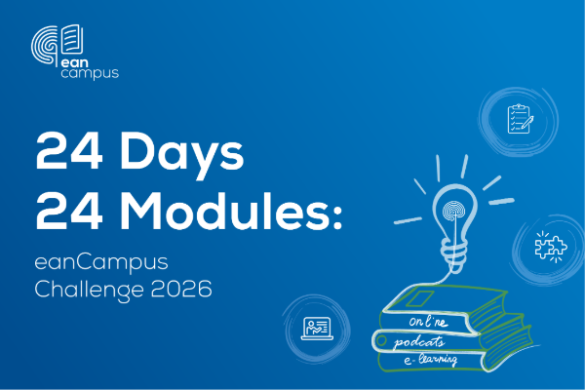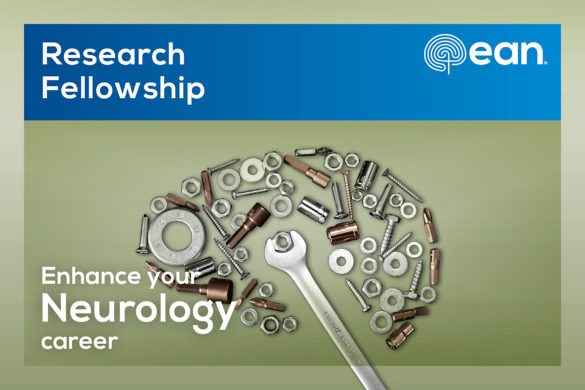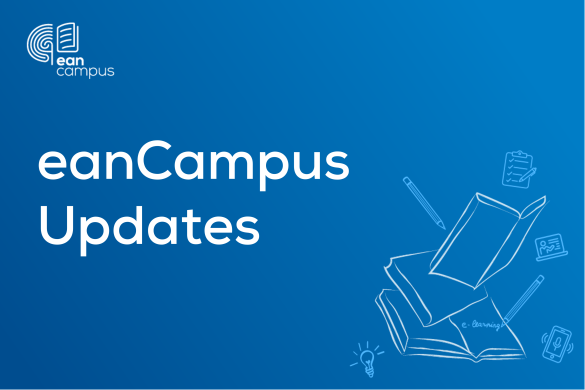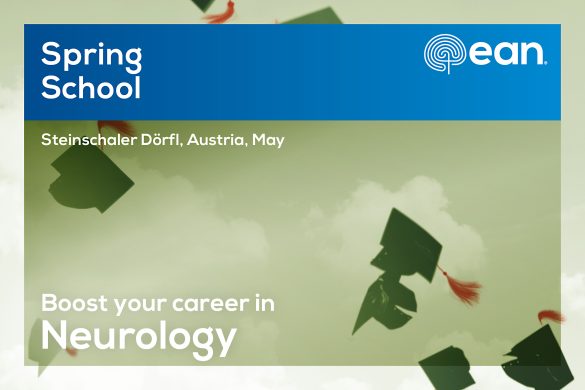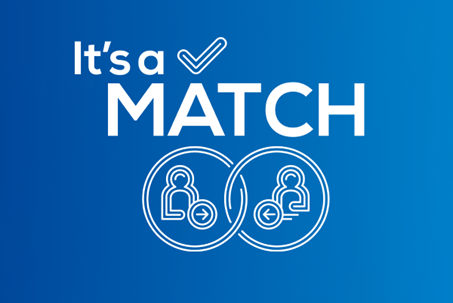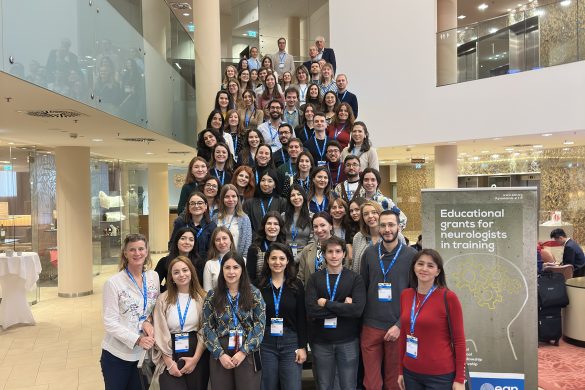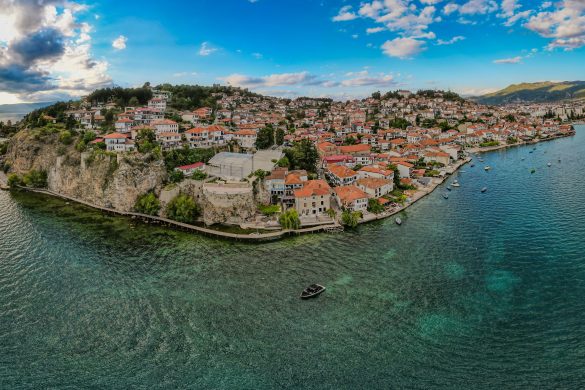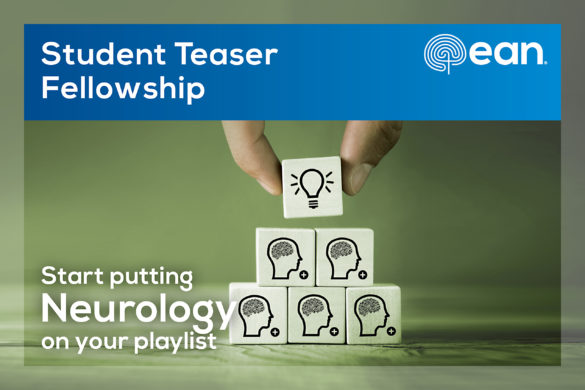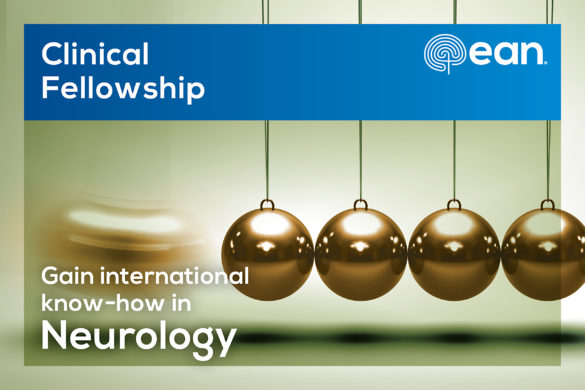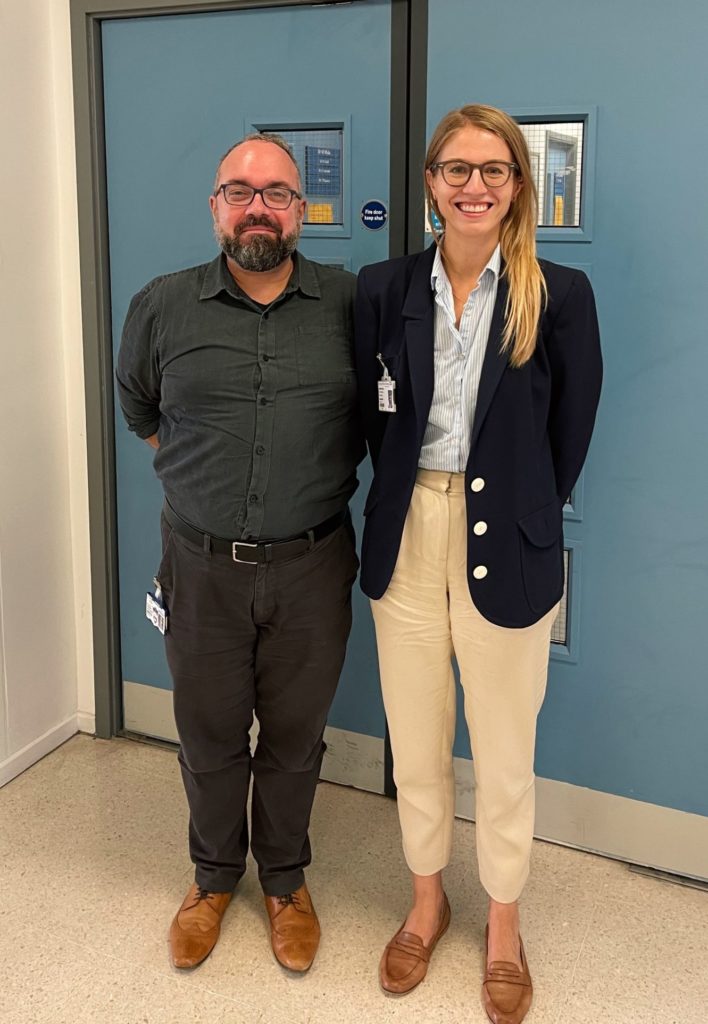
Kateriine Orav, Tallinn, Estonia
Term of the Fellowship: 13.9. – 22.10.2021
Hosting department: Department of Neurology, St George’s University Hospitals NHS Foundation Trust, London, UK
Supervisor: Dr. Marco Mula (pictured left)
I am incredibly pleased that despite a delay of one and a half years due to the COVID-19 pandemic I have finally been able to visit the Atkinson Morley Regional Neurosciences Centre in London. I embarked on this fellowship supervised by Dr. Marco Mula with an aim to learn about setting up an epilepsy service in North Estonia.
St. George’s Hospital has a versatile epilepsy service consisting of a multidisciplinary team of experts. During the fellowship I was able to join clinics with the experienced epileptologists Prof. Hannah Cock, Dr. Elizabeth Caruana Galizia and Dr. Pauls Auce and was able to observe and discuss with them their management strategies for patients with epilepsy. I was impressed by the large number of antiseizure drugs readily available in the UK and grew more experienced in their use. I learnt about the invaluable role that neuropsychiatry and neuropsychology play in the treatment and presurgical evaluation of epilepsy patients. I was very fortunate to participate in several clinics with an expert in the field, Dr. Niruj Agrawal, seeing epilepsy patients for presurgical workup as well as many patients with non-epileptic seizures. Dr. Louise Fenner very kindly invited me to join a thorough epilepsy neuropsychology evaluation taking care to explain different aspects of it alongside.
Complex epilepsy multidisciplinary meetings were held regularly to discuss more difficult cases and patients considered for epilepsy surgery or vagus nerve stimulation. During my time at St. George’s I was also able to discuss some of my more complex epilepsy patients back home my with supervisor and therefore was able to benefit some of my patients directly. I was impressed by the existence of a separate epilepsy bleep that was at the time carried by the epilepsy registrar Dr. Richard Rees. All wards and the emergency department referred patients with seizures and epilepsy for review and I learnt a lot from the discussion of these referrals with the epilepsy consultants.
The epilepsy patients under the care of St. George’s Hospital benefit greatly from the two epilepsy nurse specialists Marie Synott-Wells and Amal Abdow who offer invaluable support during their clinics as well as answer the epilepsy phone and e-mail for more urgent advice.
A regular Maternal Medicine Epilepsy Clinic is run jointly by an experienced midwife with the epilepsy nurse specialist. The clinic was set up to provide patients with epilepsy better support and follow-up during their pregnancies. St. George’s Hospital also runs a nurse-led vagus nerve stimulator clinic.
As St. George’s is a tertiary centre for tuberous sclerosis, I was able to participate in a tuberous sclerosis clinic with clinical geneticist Dr. Frances Elmslie and observe the well-organised pathway for the patients’ follow-up. I also encountered several patients with tuberous sclerosis and epilepsy in the other clinics and became more knowledgeable in complex management strategies. Throughout the weeks at St. George’s I came across patients with other rare genetic causes of epilepsy; diseases so rare that I may never encounter them in Estonia.
As St. George’s Hospital has many other specialised neurology clinics I did use the opportunity to join some of them. I was very impressed by the functional neurology clinic run by Prof. Mark Edwards, to see his expert management strategies for these complex patients. Additionally, I managed to visit some clinics dedicated to cognitive disorders, neuromuscular disorders, movement disorders and oto-vestibular disorders.
St. George’s has a very active teaching programme for its registrars, consisting of daily teaching sessions, which I was able to take part in during the fellowship. During weekly Grand Rounds, interesting and complex patients in the wards were discussed, many of whom I had previously seen during some of the ward rounds.
The clinical fellowship has given me much insight about the establishment of an epilepsy service and has greatly improved my knowledge about the management of epilepsy. I have returned to Estonia with many fresh ideas. I thoroughly enjoyed my time at St. George’s Hospital and I would like to thank all the specialists and registrars whom I had the pleasure to meet during the stay and observe their work. Finally, I am very grateful to the EAN for this tremendous programme and for being awarded the fellowship grant, as well as for allowing the fellowship to be postponed due to the pandemic.
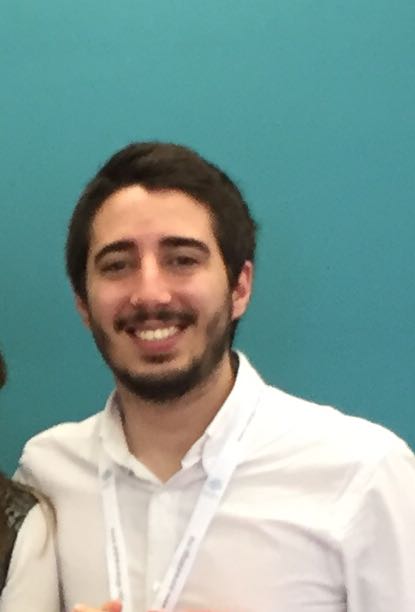
Marco António Abreu Fernandes, Lisbon, Portugal
Term of the Fellowship: 11.1. – 25.6.2021
Hosting department: Neuromuscular and Neuroimmunology Service, Clinical and Research Institute, Milan University, Milan, Italy
Supervisor: Prof. Eduardo Nobile-Orazio
I attended the Neuromuscular and Neuroimmunology Department at the Humanitas Clinical Research Institute from January to June of 2021, for a total of six months. I was under the supervision of Prof. Dr. Eduardo Nobile-Orazio and his team of five Neurologists working in the neuromuscular and neuroimmunology diseases field.
Upon arrival, Prof. Nobile-Orazio discussed the goals for the fellowship and introduced me to the different components of the Neuromuscular Department. I spent most of the days in the neurophysiology laboratory, where I learned how to perform nerve conduction studies, needle electromyography, repetitive nerve stimulation studies, motor evoked potentials, somatosensory evoked potentials, brainstem auditory evoked potentials and visual evoked potentials. The department established a learning curve for these exams: in the first two months, I was in charge of learning the stimulation points for the nerve conduction studies, and how to find the correct muscles for the required EMG, as well as to plan the exam according to the clinical picture. We performed a brief clinical history and neurological examination to delineate the nerve conduction study and, if necessary, needle EMG. In the following two months, I was responsible for the technical factors associated with this exam, learning how to use the machine and to interpret the potentials recorded. In the final two months, I was performing the exams supervised by an assistant. During this period, I performed the reports for most of the exams, which were then corrected and explained by the neurologist in charge of the neurophysiology laboratory.
Furthermore, I was also attending and evaluating patients in the Day Hospital, admitted for immunotherapies, such as intravenous immunoglobulin, rituximab and steroids, mainly for inflammatory neuromuscular diseases such as CIDP and its variants, multifocal motor neuropathy, nodoparanodopathies, anti-MAG neuropathy and inflammatory myopathies. In the Day Hospital, we evaluated the patients daily and applied different scales of outcome and disability, such as MRC sum score, INCAT and RODS. Attending the day hospital allowed me to learn the type of questions to ask the patients in order to monitor the different diseases, to adjust treatment dosages and to apply different scales used in the real world of clinical trials.
I was also able to attend the neuromuscular outpatient clinic, where I met patients with a myriad of neuromuscular diseases, such as motor neuron diseases, neuropathies, neuromuscular junction diseases and myopathies. The clinical history, the neurological examination and the different diagnosis were always discussed and explained for every patient. Furthermore, I accompanied the team in evaluating patients in the emergency department and in the different wards of the Hospital, with challenging neuromuscular diseases.
During my stay, Prof. Eduardo Nobile-Orazio also included me on the ongoing clinical trials. I was mainly responsible for the evaluation of the patients, application of questionnaires and gathering of clinical information. The professor also discussed the possibility of doing my own research with his team and, even after finishing my fellowship, we are currently trying to understand disease spreading in Multifocal Motor Neuropathy.
Regarding Italy, from January to May of 2021, Milan was closed due to the current pandemic situation, so I did not have the possibility to explore the city, nor the country. The city was slowly opening up by the end of my fellowship, and I can attest that Milan is a great city to visit, with lots of different visiting spots and activities. On the downside, living in Milan can be very expensive.
Overall, the Neuromuscular and Neuroimmunology Department at Humanitas Clinical Research Institute is the perfect balance for someone looking to learn more about the clinical aspects of neuromuscular diseases and to simultaneously develop skills regarding neurophysiology studies.
Finally, I would like to thank Prof. Eduardo Nobile-Orazio and his team for the amazing opportunity to learn from a team of experts in the field of neuromuscular diseases. I met fantastic and kind people that I will never forget, and I hope that we can meet and continue to collaborate in the near future. Finally, I would like to thank EAN for making this opportunity possible.




